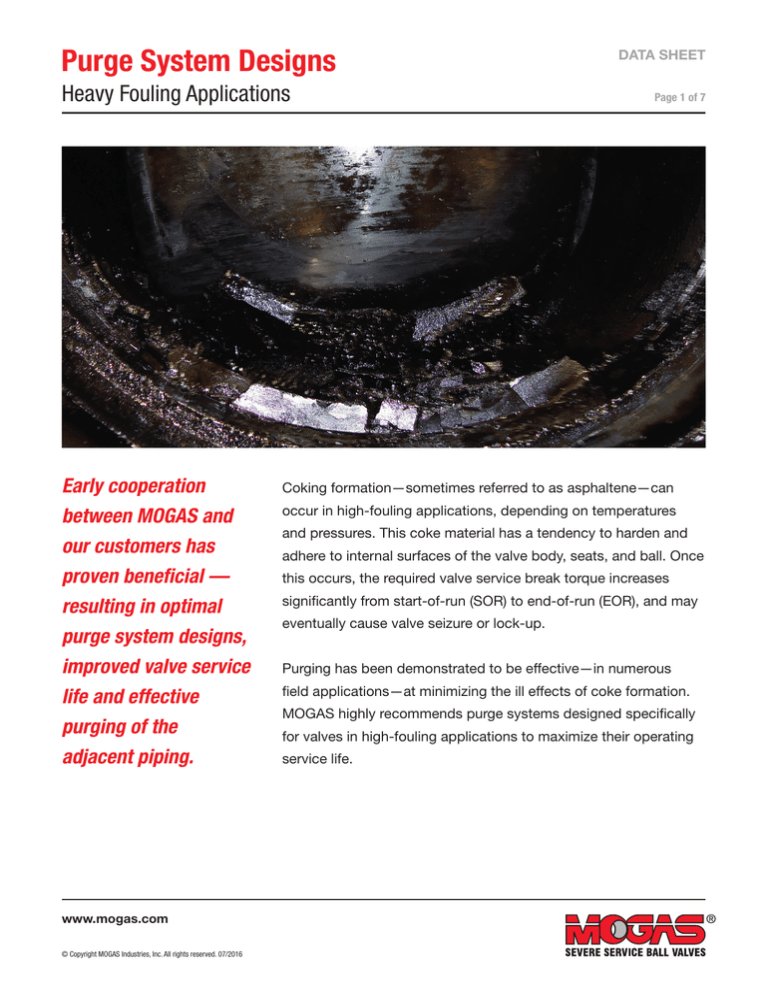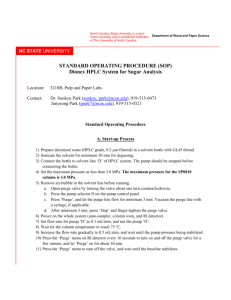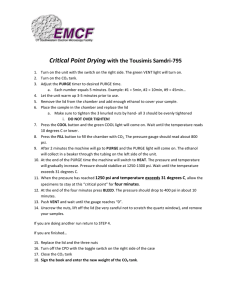
Purge System Designs
Heavy Fouling Applications
Early cooperation
between MOGAS and
our customers has
proven beneficial —
resulting in optimal
purge system designs,
improved valve service
life and effective
purging of the
adjacent piping.
www.mogas.com
© Copyright MOGAS Industries, Inc. All rights reserved. 07/2016
DATA SHEET
Page 1 of 7
Coking formation—sometimes referred to as asphaltene—can
occur in high-fouling applications, depending on temperatures
and pressures. This coke material has a tendency to harden and
adhere to internal surfaces of the valve body, seats, and ball. Once
this occurs, the required valve service break torque increases
significantly from start-of-run (SOR) to end-of-run (EOR), and may
eventually cause valve seizure or lock-up.
Purging has been demonstrated to be effective—in numerous
field applications—at minimizing the ill effects of coke formation.
MOGAS highly recommends purge systems designed specifically
for valves in high-fouling applications to maximize their operating
service life.
Purge System Designs
DATA SHEET
Heavy Fouling Applications
Page 2 of 7
Purge System Objectives
• Prevent solids buildup
• Prevent internal damage to materials and coatings,
extending life of ball and seats
• Minimize repairs between shutdowns
• Maintain cycling torque
• Maintain tight shut-off conditions
• Maintain operability of pressure instruments
• Provide valve warm-up
• Allow draining of trapped hot liquids
CFD Analysis Verifies Purge System Designs
• Computational Fluid Dynamics (CFD) analysis is used
to verify all purge designs.
• Purge locations shown are for illustration purposes only
• Actual purge designs and locations will be determined
based on application-specific data.
www.mogas.com
© Copyright MOGAS Industries, Inc. All rights reserved. 07/2016
Purge System Designs
DATA SHEET
Heavy Fouling Applications
Page 3 of 7
Purge Locations
Illustration viewed from top (12 o’clock) position. CA-1AS seat configuration shown.
III
HP
LP
I
II
V
IV
TYPE
DESCRIPTION
FLOW
Type I
Seat Pocket
In
Continuous
All valve positions = practically no purge flow.
Type II
Body Cavity
In
Continuous
Valve cycling = high volume purge flow.
Valve full open/closed = practically no purge flow.
Type III
Drain
Out
Continuous or intermittent
When activated, converts Type II purge into
continuous flow for all valve positions.
Type IV
Body Cavity + Spring + Upstream Piping
In
Continuous
All valve positions = optimized purge flow.
Type V
Flush
In
Continuous or intermittent
All valve positions = optimized purge flow.
Notes
OPERATION
1 Purge locations shown are for illustration purposes only; actual purge locations will be determined based on
application-specific data.
2 Purge types may be used independently or in combinations, depending on application requirements,
process conditions or customer preferences.
3 Mating connections are customer choice; piping and fittings beyond mating connections
are customer responsibility.
4 Compact flange connections are recommended for body; socket weld connections may be available,
based on customer specifications; consult MOGAS engineering for specific details.
www.mogas.com
© Copyright MOGAS Industries, Inc. All rights reserved. 07/2016
Purge System Designs
DATA SHEET
Heavy Fouling Applications
Page 4 of 7
Type I – Seat Pocket
One (1) inlet purge located at the pressure-end seat pocket area directs clean purge media around
perimeter of seat.
Note: Requires MOGAS seat design specific to Type I Purge for proper operation.
PROCESS
Continuous Purge Media
FLOW
All valve positions = practically no purge flow.
PURGE
Type II – Body Cavity
One (1) inlet purge located at valve body cavity delivers clean purging media to this region.
Note: This area has a tendency to accumulate heavy coke build-up.
PROCESS
Continuous Purge Media
FLOW
Valve cycling = optimized high volume purge flow.
Valve fully open / closed = practically no purge flow.
PURGE
EXIT
Type III – Drain
One (1) outlet line draws undesirable media away from valve body cavity and directs it to customer
chosen location. (Commonly directed into process stream; must include appropriate check, block
and control valves.)
PROCESS
Note: Customer is responsible for piping beyond purge connection.
FLOW
Continuous or Intermittent Purge Media
When activated, converts Type II purge into optimized purge flow for all valve positions.
PURGE
www.mogas.com
© Copyright MOGAS Industries, Inc. All rights reserved. 07/2016
Purge System Designs
DATA SHEET
Heavy Fouling Applications
Page 5 of 7
Type IV – Body Cavity + Spring + Upstream Piping
One (1) inlet purge located at valve body cavity delivers clean purging media to this region.
Unique upstream seat and spring pocket design allows purge media to flow
• between back of seat and spring
• between back of spring and spring pocket
• to upstream process piping
PROCESS
FLOW
Note: Requires MOGAS seat and spring pocket design specific to Type IV Purge for proper operation.
Not used where bi-directional sealing is required.
Continuous Purge Media
All valve positions = optimized purge flow.
PURGE
Type V – Flush
One (1) inlet purge located between the sealing seat and valve body end (clamp, flange, etc.)
introduces clean purge media into bore and piping.
Note: This design is typically used in applications with vacuum process conditions,
but may be used in other applications as well.
PROCESS
FLOW
Continuous or Intermittent Purge Media
All valve positions = optimized purge flow.
PURGE
www.mogas.com
© Copyright MOGAS Industries, Inc. All rights reserved. 07/2016
Purge System Designs
Heavy Fouling Applications
Body Connection Types
Compact Flange
• Preferred connection type used in all sizes and pressure
classes where space is available
Socket Weld
• Optional connection type for lower pressure classes with
space constraints
Customer Connection Types
MOGAS will supply valves with purge connections specified
by the customer, including:
• Raised Face Flange (RFF)
• Ring Type Joint (RTJ)
• Clamp Connector (CL)
• Welded Ends – Socket Weld (SW); Butt Weld (BW)
www.mogas.com
© Copyright MOGAS Industries, Inc. All rights reserved. 07/2016
DATA SHEET
Page 6 of 7
Purge System Designs
DATA SHEET
Heavy Fouling Applications
Optimized Purge Systems
Purge systems designed by MOGAS
for application-specific conditions
consider these factors:
• Purge design type
• Media type
• Volume and flow rate requirements
• Media pressure
• Media temperature
• Piping size
• Connection type
• Connection location
Customer Responsibilities
• Materials of construction
• Auxilliary connections to purge
piping
• Specification of purge piping to be
supplied
• Non-destructive exam requirements
• Provide purge media as specified
• Ensure all piping is safely
connected and operational
www.mogas.com
© Copyright MOGAS Industries, Inc. All rights reserved. 07/2016
Page 7 of 7
Commonly Used Purge Media
in Heavy Fouling Applications
Liquids
Gas Oils (Vacuum, Atmospheric, Coker)
Cycle Oils (Light & Heavy)
Diesels (Light & Heavy)
Naphthas (Light & Heavy)
Gases
Hydrogen
Nitrogen




